Stratford-upon-Avon is not exactly short of memorials to William Shakespeare, with statues, busts and portraits on view in many public and not so public places. But representations of his plays are less common. The earliest of these were incorporated into not one of the buildings relating to the man himself, but into a bank.
On the junction of High Street, Sheep Street, Ely Street and Church Street, stands the building called the Old Bank, rebuilt in 1883 to replace an earlier bank, and designed in high Victorian style. Coming just after the Shakespeare Memorial Theatre opened the designers, Harris, Martin and Harris of Birmingham took the opportunity to add some Shakespearean associations. So a mosaic portrait of Shakespeare and a terracotta frieze of fifteen panels each depicting a scene from a different play was incorporated into the red-brick building.
The frieze was designed by Leicester stonemason Samuel Barfield, whose work was well-known in the Midlands. His stone sculptures can still be seen on the clock tower and the Old Midland Bank in Leicester (built in 1872), the Paxton Memorial in Coventry and on the Chamberlain Fountain commemorating the mayoralty of one of Birmingham’s most influential figures, Joseph Chamberlain. This stands behind Birmingham’s Town Hall and, dating from 1880 was probably the immediate inspiration for his work on the Stratford building.
Thousands of tourists pass the Old Bank, and although many may spot the portrait, I suspect not many notice the terracotta frieze. Its position high above the heads of passers-by may have given it protection over the years, but also makes it difficult to see. The upper floor of the Town Hall is a good vantage point and I recently had the chance for a closer look. Even so I’ve had to resort to peering at them through binoculars to see the detail. Only by looking very carefully is it possible to see, in the bottom right hand corner of the Hamlet panel, the signature of S Barfield.
The panels are in three groups of four, tragedies, comedies and histories, with three single panels on the corner between comedies and histories. None are named, so identifying the plays and scenes is quite tricky. Beginning in Church Street and going round the corner into Ely Street they are:
1. King Lear Act 2 Scene 2. Cornwall, Goneril and Regan encourage Lear and the Fool to go out into the storm.
2. Hamlet Act 5 Scene 2, l 265. Claudius recoils as Gertrude, assisted by a lady, collapses. Horatio holds Hamlet back and Laertes, wounded, calls “The King, the King’s to blame”.
3. Macbeth, Act 1 Scene 3, l 50. The three weird sisters appear to Banquo and Macbeth “All Hail, Macbeth”.
4. Othello, Act 5 Scene 2. Emilia pulls back the curtain to reveal Desdomona’s murdered body. Othello stands by, watched by Montano.
- King Lear
- Hamlet
- Macbeth
- Othello
5. As You Like It, Act 3 Scene 5. Phoebe, Silvius, Rosalind, Celia and Corin.
6. The Two Gentlemen of Verona, Act 5 Scene 4, l 63. Valentine challenges Proteus who is attacking Silvia, while Julia stands by, watching. “Ruffian, let go that rude uncivil touch”.
7. A Midsummer Night’s Dream, Act 3 Scene 1, l 74. Quince calls out as Bottom appears to the mechanicals wearing the ass’s head. “O monstrous! O strange! we are haunted”. Puck watches from above.
8. Twelfth Night, Act 3 Scene 4, l 231. Sir Toby eggs on Sir Andrew to fight with Viola, backed up by Fabian.
- As You Like It
- The Two Gentlemen of Verona
- A Midsummer Night’s Dream
- Twelfth Night
9. Coriolanus, Act 5 Scene 3. Virgilia stands with Young Martius who kneels, while Volumnia pleads with her son Coriolanus.
10. The Merchant of Venice, Act 3 Scene 2, l 75. Nerissa and Portia watch Bassanio make his choice of the caskets watched by Gratiano and a boy.
11. Antony and Cleopatra, act 3 Scene 11, l 42. Cleopatra, supported by Charmian approaches Antony who is in despair after losing the battle. Eros addresses him “Most noble sir, arise, the queen approaches”.
- Coriolanus
- The Merchant of Venice
- Antony and Cleopatra
12. Henry V, Act 3 Scene 1, l 1. “Once more unto the breach”. Henry leads his troops at the siege of Harfleur.
13. Richard II, Act 3 Scene 3, l 192. Outside Flint Castle, Bolingbroke kneels to Richard “Fair cousin, you debase your princely knee”. Bolingbroke’s supporters are Northumberland, Percy and York, while behind Richard are the Bishop of Carlisle and Aumerle.
14. King John, Act 4 Scene 3, l 96. The Bastard intervenes between Salisbury who has drawn his sword and Hubert, over the body of Prince Arthur. Pembroke and Bigot stand by watching.
15. Richard III, Act 1 Scene 2, l 190. Richard offers his breast to Lady Anne for her to kill him. “Nay, now dispatch: ’twas I that stabbed young Edward”.
- Henry V
- Richard II
- King John
- Richard III
Line reference are all to the RSC Shakespeare edition. If you receive these as emails and wish to see the images in full you should click on the link at the end of the mail to go to the blog itself.
The choice of plays and subjects is interesting: why the unpopular The Two Gentlemen of Verona rather than those Victorian favourites The Taming of the Shrew, Much Ado About Nothing or The Merry Wives of Windsor? Why no Romeo and Juliet? And why, instead of the rather glum scene from Antony and Cleopatra didn’t he portray one of the great scenes from Julius Caesar?
There’s no attempt to reproduce scenes from popular productions of the plays, and little reference to paintings of the plays, so I assume Barfield decided to illustrate scenes that appealed to him from reading the plays. The only panel that reminds me of a painting is The Two Gentlemen of Verona, reminiscent of Angelica Kauffmann’s painting of the same subject. The panels have been designed with considerable care, so on the As You Like It panel Phoebe holds a shepherd’s crook, in Hamlet the poisoned cup from which Gertrude has drunk lies under Hamlet’s feet, and in the King Lear panel, as Lear and the Fool exit into the storm a dog sits between Goneril and Regan. I wonder if it’s a reference to Cordelia’s lines “Mine enemy’s dog/ Though he had bit me should have stood than night/ Against my fire” . In the A Midsummer Night’s Dream panel one of the actors’ scrolls lies forgotten as the mechanicals scatter. Behind the figures of Richard III and Lady Anne can just be seen the coffin of Henry VI, and Henry V’s soldiers carry the ladders to break the siege of Harfleur. One detail that’s very difficult to see is the single piece of Shakespeare’s text, the greeting from the weird sisters: “All hail Macbeth”. I’m intrigued by the figure staring out of The Merchant of Venice panel who looks like Barfield’s portrait of Shakespeare. The panels have sustained surprisingly little damage though Henry V has lost the sword he once brandished.
Next time you’re in Stratford-upon-Avon, take a look at these charming representations of scenes from Shakespeare. They’re worth the trouble, but you’ll have to bring your own binoculars!

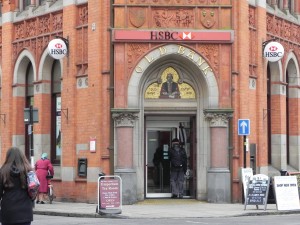
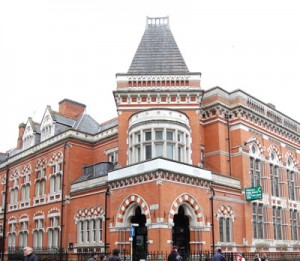
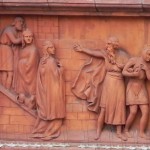
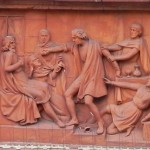
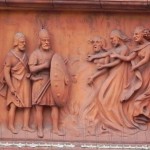
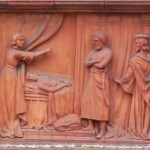
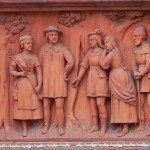
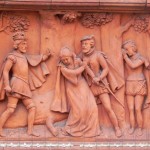
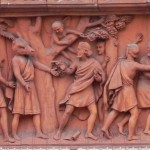
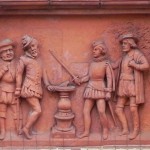
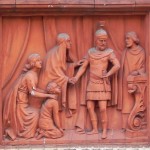
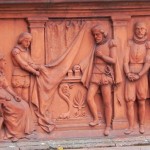
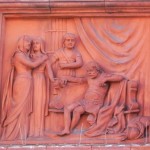
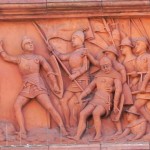
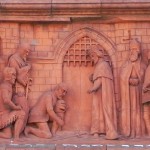
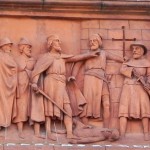
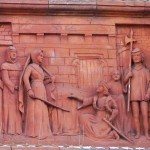
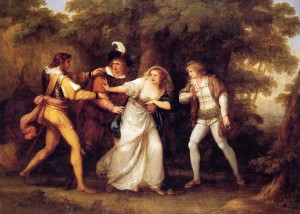

What a fascinating blog, Sylvia. I’ve always loved the buiilding and the panels, but did not know about the other associated places and people
Prof. Dr. Christa Jansohn
Lehrstuhl für Britische Kultur
Otto-Friedrich-Universität Bamberg
Kapuzinerstr. 16
D-96047 Bamberg
Hello from Germany,
for more information about the terra cotta relief panels see my article which was published in January 2012.:
Christa Jansohn: “From Stratford to Weimar: Scenes from Shakespeare”, in: Shakespeare. Satire. Academia. Ed. S. Fielitz et al. Heidelberg: Universitätsverlag, 2012. Pp. 221-240.
The is a copy in the Shakespeare Centre library. If you are interested in the article I am happy to send an off-print.
With best wishes,
Christa Jansohn (christa.jansohn@uni-bamberg.de)
E-Mail: christa.jansohn@uni-bamberg.de
http://www.uni-bamberg.de/britcult/
Co-Editor: Archiv fuer das Studium der Neueren Sprachen und Literaturen:
http://www.esv.info/z/ARCHIV/zeitschriften.html
Co-Editor: Editionen in der Kritik:
http://www.weidler-verlag.de/Reihen/Berliner_Beitr__zur_Editionswi/berliner_beitr__zur_editionswi.html
Dear Christa
Thank you so much for this information, I didn’t know about your article, and I will check it out at the Shakespeare Centre.
These are lovely, thank you so much for sharing them! I like your idea that the scene choices are personal favourites from the plays – some of them are the Big Moment from its play, like Henry V, but the one in Twelfth Night isn’t an obvious choice at all.
I just love the body language in them – these are really gorgeous.
Pingback: Shakespeare’s scenes in terracotta | heavenhappens